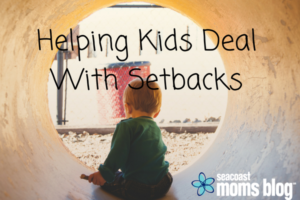 Setbacks are a part of life. Each one of us has experienced big disappointments after big efforts. Dealing with setbacks is difficult for everyone, and it can be excruciating for our children–especially when their self-confidence is continuously developing. We adults know how to cope, but our children may not. What can we do?
Setbacks are a part of life. Each one of us has experienced big disappointments after big efforts. Dealing with setbacks is difficult for everyone, and it can be excruciating for our children–especially when their self-confidence is continuously developing. We adults know how to cope, but our children may not. What can we do?
I like to think of setbacks as little tests.
Sometimes setbacks test our abilities. Or maybe they test our character. They can test our motivation, too. So when a setback occurs, we have to think about the best way to move forward.
Moving forward after a setback is personal for everyone. We all have our own ways of handling disappointments. I have found the following four things helpful in moving forward after a setback–both for me and my child. Maybe they will work for you, too.
The T.E.S.T.s of Setbacks:
Teach them self-love.
- Oftentimes, a setback isn’t your fault. It’s important to emphasize kindness and self-love when someone is at a low point. For kids, this can be extremely difficult after a disappointment. They can rip themselves apart so harshly with cruel words that simply do no good.
- Help your kids say something positive about themselves such as, I love that I tried, I made a good effort, and I love myself!
Establish a growth mindset.
- I’m an ESL teacher, and one branch of learning psychology that I find fascinating is a Growth Mindset vs. Fixed Mindset. A growth mindset is one in which we cultivate an attitude that leads to growth and success. It teaches us to take calculated risks and appreciate the challenges and efforts it takes to overcome them. This differs from a fixed mindset that holds an “I am what I am and I can’t change” attitude.
- Helping our kids cultivate a growth mindset can be done through constructive feedback that puts emphasis on effort and process instead of unfocused praise.
[box]
- Instead of saying “Great job!” —> Try, “You found a really interesting way to figure that out!” And when our kids have a setback, we can help them shift towards this growth mindset.
- I can’t do it! —> I need to look at what happened and see where I can make changes.
- I give up! —> I will try again and use a different way.
A growth mindset teaches kids that learning is a process and abilities can be developed. For some more examples, check out MindsetWorks.
[/box]
Set new goals.
Goal setting is the key to keeping a child’s motivation high. And when our kids have setbacks, we need to step in and help them self-motivate. We need to help them look at their current goals and make adjustments. Sometimes it means starting over with a completely different goal, and that’s okay. Goals are what keeps a person moving forward.
Try, try, again.
- When I was growing up, my mother used to always say, “If at first you don’t succeed, try, try again.” I heard that phrase so often that I got annoyed with it. But it also stuck with me.
- Resilience is an important skill that children need. The ability to bounce back and step up to the plate again after a loss is hard. Sometimes a second try feels useless or humiliating. But a second attempt needs to take place so that new perspectives can be formed.
- Let your children decide when to try again. Maybe right away is not the right time. Sometimes kids need a complete break. Maybe they need to take a step back from the challenge for a while – be it a few days, several months, or even years.










